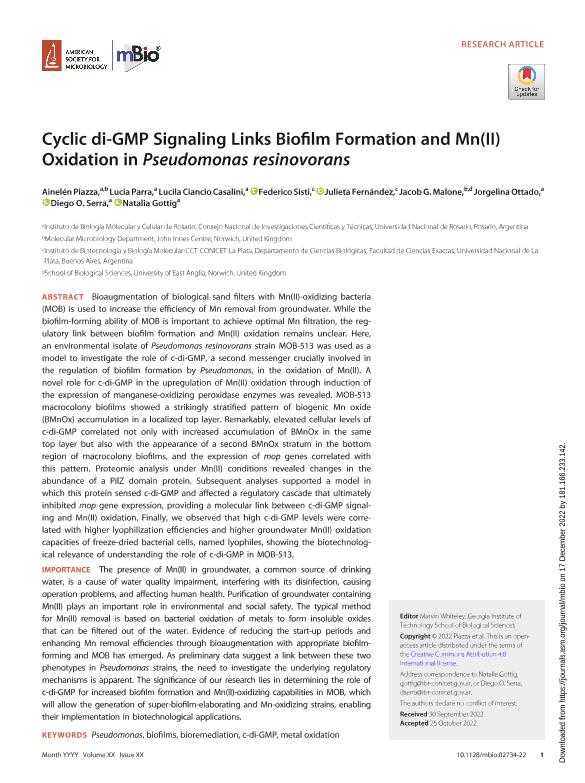Artículo
Cyclic di-GMP Signaling Links Biofilm Formation and Mn(II) Oxidation in Pseudomonas resinovorans
Piazza, Ainelén Melanie ; Parra, Lucia; Ciancio Casalini, Lucila
; Parra, Lucia; Ciancio Casalini, Lucila ; Sisti, Federico Bernardo
; Sisti, Federico Bernardo ; Fernandez, Julieta
; Fernandez, Julieta ; Malone, Jacob G.; Ottado, Jorgelina
; Malone, Jacob G.; Ottado, Jorgelina ; Serra, Diego Omar
; Serra, Diego Omar ; Gottig Schor, Natalia
; Gottig Schor, Natalia
 ; Parra, Lucia; Ciancio Casalini, Lucila
; Parra, Lucia; Ciancio Casalini, Lucila ; Sisti, Federico Bernardo
; Sisti, Federico Bernardo ; Fernandez, Julieta
; Fernandez, Julieta ; Malone, Jacob G.; Ottado, Jorgelina
; Malone, Jacob G.; Ottado, Jorgelina ; Serra, Diego Omar
; Serra, Diego Omar ; Gottig Schor, Natalia
; Gottig Schor, Natalia
Fecha de publicación:
11/2022
Editorial:
American Society for Microbiology
Revista:
mBio
ISSN:
2150-7511
Idioma:
Inglés
Tipo de recurso:
Artículo publicado
Clasificación temática:
Resumen
Bioaugmentation of biological sand filters with Mn(II)-oxidizing bacteria (MOB) is used to increase the efficiency of Mn removal from groundwater. While the biofilm-forming ability of MOB is important to achieve optimal Mn filtration, the regulatory link between biofilm formation and Mn(II) oxidation remains unclear. Here, an environmental isolate of Pseudomonas resinovorans strain MOB-513 was used as a model to investigate the role of c-di-GMP, a second messenger crucially involved in the regulation of biofilm formation by Pseudomonas, in the oxidation of Mn(II). A novel role for c-di-GMP in the upregulation of Mn(II) oxidation through induction of the expression of manganese-oxidizing peroxidase enzymes was revealed. MOB-513 macrocolony biofilms showed a strikingly stratified pattern of biogenic Mn oxide (BMnOx) accumulation in a localized top layer. Remarkably, elevated cellular levels of c-di-GMP correlated not only with increased accumulation of BMnOx in the same top layer but also with the appearance of a second BMnOx stratum in the bottom region of macrocolony biofilms, and the expression of mop genes correlated with this pattern. Proteomic analysis under Mn(II) conditions revealed changes in the abundance of a PilZ domain protein. Subsequent analyses supported a model in which this protein sensed c-di-GMP and affected a regulatory cascade that ultimately inhibited mop gene expression, providing a molecular link between c-di-GMP signaling and Mn(II) oxidation. Finally, we observed that high c-di-GMP levels were correlated with higher lyophilization efficiencies and higher groundwater Mn(II) oxidation capacities of freeze-dried bacterial cells, named lyophiles, showing the biotechnological relevance of understanding the role of c-di-GMP in MOB-513. IMPORTANCE The presence of Mn(II) in groundwater, a common source of drinking water, is a cause of water quality impairment, interfering with its disinfection, causing operation problems, and affecting human health. Purification of groundwater containing Mn(II) plays an important role in environmental and social safety. The typical method for Mn(II) removal is based on bacterial oxidation of metals to form insoluble oxides that can be filtered out of the water. Evidence of reducing the start-up periods and enhancing Mn removal efficiencies through bioaugmentation with appropriate biofilm-forming and MOB has emerged. As preliminary data suggest a link between these two phenotypes in Pseudomonas strains, the need to investigate the underlying regulatory mechanisms is apparent. The significance of our research lies in determining the role of c-di-GMP for increased biofilm formation and Mn(II)-oxidizing capabilities in MOB, which will allow the generation of super-biofilm-elaborating and Mn-oxidizing strains, enabling their implementation in biotechnological applications.
Palabras clave:
BIOFILMS
,
BIOREMEDIATION
,
C-DI-GMP
,
METAL OXIDATION
,
PSEUDOMONAS
Archivos asociados
Licencia
Identificadores
Colecciones
Articulos(IBBM)
Articulos de INST.DE BIOTECNOLOGIA Y BIOLOGIA MOLECULAR
Articulos de INST.DE BIOTECNOLOGIA Y BIOLOGIA MOLECULAR
Articulos(IBR)
Articulos de INST.DE BIOLOGIA MOLECULAR Y CELULAR DE ROSARIO
Articulos de INST.DE BIOLOGIA MOLECULAR Y CELULAR DE ROSARIO
Citación
Piazza, Ainelén Melanie; Parra, Lucia; Ciancio Casalini, Lucila; Sisti, Federico Bernardo; Fernandez, Julieta; et al.; Cyclic di-GMP Signaling Links Biofilm Formation and Mn(II) Oxidation in Pseudomonas resinovorans; American Society for Microbiology; mBio; 13; 6; 11-2022; 1-18
Compartir
Altmétricas



